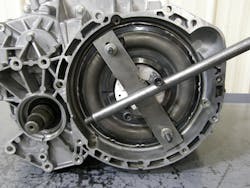Rather than a gear and crescent type of pump, General Motors uses a vane type pump in many of their transmissions. Originally, this style pump had 10 vanes in the rotor. Back in 1997, they redesigned the rotor to be able to house 13 vanes. According to G.M., this was done to reduce pump whining and pressure regulator valve buzzing noises. We continue to see this style pump and rotor to this very day. Such as the rear wheel drive 2 mode hybrid transmission and the 6L80 series transmissions.
From time to time, our technical hotline receives calls where the rotor has shattered. Sometimes this is the reason for the transmission being in the shop. And other times this occurs after the transmission was rebuilt. An example of this can be seen with a 5L40-E transmission. This transmission is used in both GM and BMW vehicles.
The question that often times come up is why does the rotor shatter? It may be one simple question, but there are many answers as well as continued speculation. The intent of this article is to provide some confirmed reasons for this problem which can be used to eliminate all “known” possibilities.
When the rotor changed from driving 10 vanes to 13, there is less material between the vanes making it structurally more prone to breakage. Especially since it is not made of solid steel but from a process called powder metallurgy, which is the blending of fine powdered materials and pressing them into a desired shape or form. With proper conditions, this rotor can hold up to the task at hand as testified by transmissions that have seen over 100,000 miles. But when conditions are compromised, it’s a shattering experience.
To start with, most of the transmissions using this style pump; line pressure is controlled electronically via a line pressure control solenoid. There are many codes that can set (both engine and transmission) which will elevate line pressure. If the driver chooses to ignore the illuminated malfunction indicator light and bumpy shifts, the engine is continuously driving a pump with higher than normal line pressure. This places additional stress on the rotor which eventually will cause it to shatter, particularly during idle conditions. The same is true if the pressure control solenoid mechanically fails high or the pressure regulator valve is sticking.
Another concern is if the pump can suck in air past the filter. Aerated fluid places a different type of stress on the rotor. It causes the rotor to vibrate if you will as it is being driven through air and fluid. Typically this can be determined by seeing plenty of bubbles on the dip stick or by a very erratic pressure gauge.
A bad filter or a poor quality filter would be another reason. Similar to low fluid levels, fluid restriction through the filter can starve the pump causing the rotor to shatter.
If the torque converter is not indexed deep enough into the rotor, the force being placed on the rotor is not being properly distributed. In some cases, the converter barely catches the rotor and will slip out and run across the surface of the rotor causing it to shatter.
Alignment is critical with the converter, with the transmission as well as with the pump in some instances. If the converter neck is misaligned, flywheel issues, compromised or missing engine block alignment pins, all will contribute to rotor destruction.
FIGURE 1Then of course the pump itself can be the culprit. Excessive wear with pivot pins, pump slides, pump pockets, rotors and vanes will easily give way to any of the possibilities just covered. It is good to always check all clearances especially when replacing parts (Figure 1).
When we offer these known causes to those fighting shattered rotors, most never come back after eliminating these possibilities. So while the jury may be out deliberating on other possibilities, one or two of the items mentioned here will usually free you from some jail time.
Subscribe to Motor Age and receive articles like this every month…absolutely free. Click here


